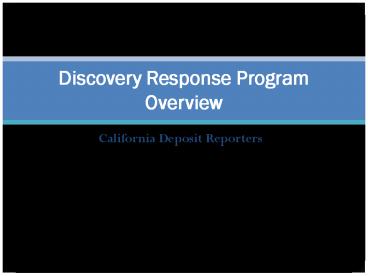Discovery Response Program Overview - PowerPoint PPT Presentation
Title:
Discovery Response Program Overview
Description:
California Deposition Reporters is generally used within two categories of cases. First, a party in a civil case will request discovery from a non-party without a lawyer. Second, the party or attorney in a criminal case will request discovery from a party or attorney. – PowerPoint PPT presentation
Number of Views:28
Title: Discovery Response Program Overview
1
Discovery Response Program Overview
- California Deposit Reporters
2
- Discovery Response Program and Legal Hold are
terms that are used in the legal field. These two
terms are often confused with each other and when
this happens, we get the wrong answers to our
questions. Discovery is defined as the process
where a party seeks the production of documents,
data, information or oral evidence from another
party. Discovery Response is the answer to any
questions that the client may have about the case
and the Discovery Response is what is used to get
the documents and information that are needed. If
you are a client of Discovery Response Service,
you need to understand the differences between
Discovery Response Program and Legal Hold. - Discovery Response is not an attorney client
relationship. It is strictly an agreement between
Discovery and the client. Discovery court
reporting Service will ask the question that the
client was willing to answer or they will make
sure the client was willing to answer before
allowing them to proceed with producing the
documents. In many cases this is done without
having an attorney present because it will show
the client was cooperative and the Discovery
Response is not an attempt for an attorney to win
the case for them.
3
- Discovery is a Courtroom process designed to
provide information to assist the attorneys in
understanding the case, reviewing pleadings, and
determining whether or not there is a case
against a particular person, entity or even a
pattern of behavior. Discovery is very important
to a successful litigation case, because it
provides the attorney with more information about
the opposing parties and their defenses.
Discovery is also an adversarial tool used in
resolving cases. A party requesting discovery is
always trying to discover any facts, information,
documents, opinions, and oral or written
statements by the opposing parties that will help
them with their position. A client seeking
discovery generally requests it of both parties. - Discovery is only relevant if both parties agree
and there is a case against one party. Discovery
is designed to produce documentation and
information that are relevant to the case that
the client is involved in. It is intended to
enhance the case by providing additional
information that can be used at trial or to make
evidentiary support to a jury's decision.
Discovery is not to be used as a summary of the
case, and any witness must be allowed to testify
and to provide testimony about the matter they
are called to testify about.
4
- California Deposition Reporters is generally used
within two categories of cases. First, a party in
a civil case will request discovery from a
non-party without a lawyer. Second, the party or
attorney in a criminal case will request
discovery from a party or attorney. A request for
discovery is made by filing a "Discovery Request"
with the court's clerk. There is a time period
for receiving discovery from either party,
including a deadline for discovery services,
unless the court rules otherwise. - Discovery is not limited to before trial a party
may use discovery at any time before the case is
tried. If a lawyer is retained to handle a case,
then the Discovery Response Program can be used
to submit interrogatories, answer
interrogatories, etc. In addition, discovery can
be used to obtain financial records, appraisals,
depositions, etc. In essence, discovery is
designed to assist the client in pre-trial
research and review of the subject matter, but
discovery does not have an effect on the lawyer's
liability or client-lawyer relationship. However,
a lawyer may limit discovery so as not to
disclose more information than is necessary to
assist their client in preparing their defense.
5
- The discovery response program can also include
the production of additional reports and
examiners' opinions. These reports may be used by
the defense and the prosecution. Examples of
possible reports include FBI forensic
examinations, tests, photographs, autopsies, etc.
Generally speaking, an attorney handling a
client's discovery response program will work in
conjunction with his or her legal office, in an
effort to craft the appropriate discovery
response. It should be noted that discovery
responses do not need to be comprehensive any
and all documents and information concerning the
client's case and the underlying controversy will
qualify. - Discovery is most often limited to medical expert
witnesses, such as radiologists or physicians.
Examples of possible discovery are doctor's
observations, medical records, prescription
records, etc. However, discovery can also cover
all information and records (from depositions,
etc.), electronic or physical copies of records,
and written works (copies of legal documents and
letters). Additionally, a lawyer may request a
privilege to preserve any tangible item produced
in discovery so long as it is not used in the
course of the case.
6
THANK YOU































